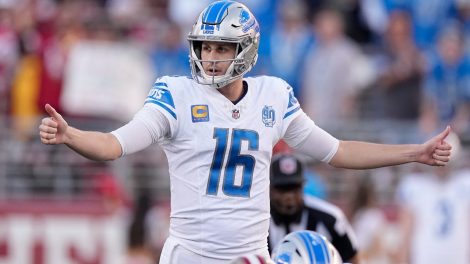Super Bowl LII is a fascinating contrast: a team everyone predicted would be here against a team no one believed could make it this far, especially after losing its franchise quarterback in December.
The New England Patriots and Philadelphia Eagles have taken very different roads to this year’s title game, but a look at each team by their regular-season and playoff numbers reveals interesting similarities.
So how do the Patriots and Eagles stack up? Here’s a look at both team’s numbers through 18 games, and a breakdown of six of those stats that will have a major impact on Super Bowl LII.
2017 Regular-season Stats
*38 Passing TDs, Eagles (1st): Philly finished the regular season with the most passing touchdowns, but 33 of those were thrown by injured quarterback Carson Wentz. Nick Foles threw the other five in nine quarters of relief.
The loss of Wentz and the unexpected re-emergence of Foles has been the storyline surrounding the Eagles this post-season. Foles is having an historically impressive playoff run while Philadelphia’s franchise player stands on crutches along the sideline.
Foles and the Eagles’ offensive coaching staff have done an excellent job at creating and executing perfect game plans over their last two games. How Philadelphia approaches the Patriots — and how Bill Belichick and Matt Patricia plan to counter — might be the most fascinating matchup of Super Bowl LII.
**366 yards allowed per game, Patriots (29th): Defensively, 2017 was a tale of two seasons for the Patriots. New England gave up more than 400 yards to opposition in each of their first six games, including 537 to the Kansas City Chiefs in that shocking opening-night loss. But since giving up 408 yards to the New York Jets in a closer-than-it-should-have-been victory, Patricia’s defence has coughed up more than 400 yards just once — in that thrilling Week 15 win over the Steelers — and held opponents to fewer than 300 yards four times.
Don’t expect the Patriots to be as susceptible to the Eagles offence as the Vikings were in the NFC championship: After giving up more than 440 yards per game in the first month and a half of the season, New England is giving up just 321 per game over their last 12.
[relatedlinks]
***38 sacks, Eagles (15th): Philadelphia’s middle-of-the-pack ranking in the sacks column isn’t indicative of the dominance of the team’s defensive line, which is arguably the deepest in the league. Led by human wrecking ball Fletcher Cox, Philadelphia boasts a defensive front four that is able to rotate as many as eight effective players throughout the game. Backups Chris Long and Derek Barnett, for example, made two of the biggest plays in the Eagles divisional win over the Atlanta Falcons.
One of the biggest bonuses of such depth? Cox and Brandon Graham weren’t required to play nearly as many regular-season snaps as contemporaries around the NFL, meaning they’ve been fresh throughout this playoff run. And it shows.
2017 Post-season Stats
*73.5 rushing yards per game, Patriots (10th): The Patriots are 10th out 12 playoff teams in rushing yards per game, a stat that is misleading at first glance. New England’s offence relies heavily on running backs making plays by catching Tom Brady passes out of the backfield, a trait amplified this season by the loss of Julian Edelman last summer. Dion Lewis, James White and Rex Burkhead combined for 514 receiving yards during the regular season, with Lewis and White making up more than 25 per cent of New England’s pass offence so far this post-season.
So while it may look like the Patriots’ ground game is struggling, New England’s running backs are very much a factor heading into Super Bowl LII.
**8.5 points allowed per game, Eagles (1st): Home-field advantage was exactly that for the Eagles defence over the last two games, as Philadelphia’s defence has been stellar at Lincoln Financial Field. Jim Schwartz’s unit allowed just 7.2 points over their last five home games, and recorded shutouts in the second halves of both playoff games.
Obviously, the Eagles lose that edge for the Super Bowl in Minnesota, but the stinginess of Philadelphia’s fourth-ranked defence is a big storyline heading into Sunday’s game.
***11 sacks, Patriots (1st): The Patriots have four more sacks than any other playoff team, but that number is inflated by an eight-sack performance in their divisional win over the Tennessee Titans. That’s not to take away from a relatively unknown Patriots front seven that, as noted above, racked up 42 sacks in the regular season. But New England faces a much stiffer test against an Eagles offensive line that is playing the best it has all season.








